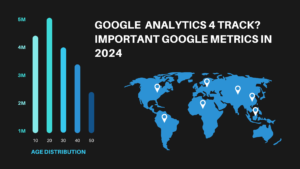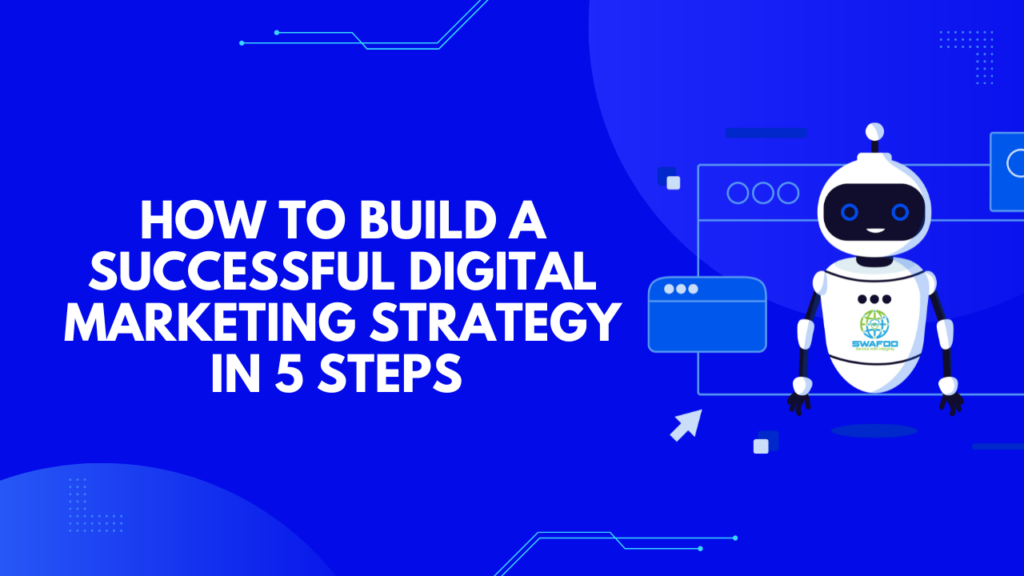
How to set up Google Analytics
Google Analytics 4 Track? Important Google Metrics in 2024 Creating exceptional content takes time and effort, and naturally, you want to know how well it’s

In today’s rapidly changing digital landscape, establishing a strong digital marketing strategy is crucial for businesses looking to stay ahead of the curve. With an estimated 4.2 billion active internet users worldwide, having a compelling online presence has become the norm for companies looking to reach their target audience.
To build a successful digital marketing strategy can seem overwhelming, as there are numerous platforms and methods available. However, by following a concise process, businesses of all sizes can create a comprehensive and effective digital marketing plan.
In this article, we will discuss the importance of establishing a strong digital marketing strategy and provide an overview of five simple steps to create a successful plan. These steps include identifying your target audience, setting clear goals, determining your budget, choosing the right channels, and regularly evaluating and adjusting your strategy.
By following these steps, businesses can maximize their online potential, increase their brand awareness, and reach their target audience more effectively. Let’s dive into the world of digital marketing and explore how to build a successful strategy in five simple steps.
Defining your target audience is an essential step to create a successful digital marketing strategy. It’s important to allocate time and resources to analyze and understand your customers fully. Developing buyer personas is a great way to humanize and segment your audience, allowing you to craft personalized messaging and experiences that resonate better with them. These personas should be based on data collected from customer analytics, as it helps you identify patterns and insights that could drive strategy improvements.
Knowing your target audience can also help you make better decisions around message delivery, media mix, and budget allocation. Your strategy involves tailoring messages and creative assets according to your audience’s interests and behaviors. Customer data analytics allows you to further refine your targeting and messaging, as it enables you to analyze the performance of different channels and campaigns. Spending some time on understanding your audience can help you create compelling, relevant experiences that ultimately translate into increased conversions and long-term customer loyalty.
Establishing a unique selling point is vital to the success of any business, especially in a highly competitive marketplace. To differentiate yourself from your competitors, it is essential to analyze and understand your target audience. Spending time to meet your customers and identify their key needs and preferences should be an integral part of creating a digital marketing strategy.
This strategy involves identifying the key benefits of your product or service that sets you apart from the rest. To begin, conducting a thorough market analysis can help you determine the gaps and opportunities that currently exist in your industry. This information can then be used to create a competitive edge and unique value proposition for your business. Differentiation can come in the form of features, pricing, convenience or customer service. Once you have identified your unique selling point, your marketing messages should be tailored towards highlighting these benefits.
In conclusion, determining your unique value proposition requires extensive research and analysis. By taking the time to understand your customers, you can differentiate yourself from your competitors and effectively communicate the key benefits of your business. This enables you to create a digital marketing strategy that successfully targets and attracts your ideal target audience.
The ever-evolving landscape of digital marketing can be both an exciting and daunting prospect for businesses. But with the right approach, time, and investment, it can be a powerful tool for driving growth and engagement. Developing a solid strategy means taking advantage of the plethora of digital channels available to reach your target audience. Platforms like Facebook, Google Ads, and Instagram all offer unique opportunities to connect with consumers.
However, it’s important to select the right tactics for your audience. This starts with understanding your target demographic, their behavior and preferences. Creating a content strategy is also crucial, as it allows you to craft messaging and assets that effectively engage with your target audience. This can include website content, e-books, social media posts, and articles. In today’s trend-driven world, having a consistent, high-quality stream of content is essential in building brand recognition and authority.
This is where tools like Google Analytics, Hootsuite, and Buffer come in. Not only do they allow you to create content, but they also help you analyze and measure the effectiveness of your campaigns, making it easier to make data-driven decisions. Ultimately, success in digital marketing is about utilizing the available tools to identify and target what works for your business and customers, actively adapting and tweaking your approach as necessary.
Alright, so listen up folks. It’s super important that we create a budget and timeline when it comes to creating some killer content, got it? Like, seriously, this is how we’re going to make sure we stay on track and don’t lose our minds trying to juggle everything.
So let’s get into it. When we create a solid budget and timeline, we can really engage our audience and make sure we’re meeting our goals. We need to establish a realistic timeline so we don’t burn out and end up creating subpar content. And when it comes to allocating our budget effectively, we need to be smart about where we put our money. That means thinking strategically about which digital channels we’re going to use.
We also need to keep an eye on trends, because they can help us figure out what kind of content is going to be most effective. And you know what? We’ve got some awesome tools like analytics to help us make those decisions. So let’s not waste any more time, friends. Setting a budget and timeline is, like, priority number one. Trust me, it’s going to make our lives so much easier in the long run.
Analyzing and optimizing your strategy is a critical aspect of running any successful business. It is essential to continuously monitor and evaluate your efforts to ensure that they are yielding desired results. The first step towards achieving this involves collecting measurable data about your business and its performance. Measurable metrics such as website traffic, conversion rates, and customer acquisition costs are crucial in analyzing the effectiveness of your strategy. Regularly tracking these metrics will help you identify trends and patterns, as well as opportunities for improvement.
Making data-driven adjustments is key to optimizing your strategy. For instance, if your data shows that visitors are leaving your website without making any purchases, you may need to re-evaluate your website’s user experience or adjust your pricing strategy. Similarly, if your customer acquisition costs are consistently high, you may need to explore alternative marketing channels to reduce costs and improve efficiency.
It is imperative to have a well-defined plan of action that outlines the specific metrics to track, the frequency of collection, and the methods of analysis. Assigning clear responsibilities and timelines to team members will not only ensure accountability but also help to identify gaps and opportunities to improve your strategy further. Additionally, regularly reviewing your progress against your goals will provide insights on the success of your strategy and allow for appropriate adjustments.
In conclusion, analyzing and optimizing your strategy is paramount for any business that aims to thrive in a competitive marketplace. Continuous analysis and optimization involving measurable metrics and data-driven adjustments ensure that your strategy remains relevant and effective. By following the outlined steps and assigning clear responsibilities, your business can achieve its desired outcomes and stay ahead of the competition
In conclusion, building a successful digital marketing strategy is a complex process, but it doesn’t have to be overwhelming. By following the five simple steps, businesses can create a strong foundation for their online presence, increasing their chances of achieving their marketing goals. To recap, these steps include defining a clear target audience, conducting thorough market research, setting specific and measurable objectives, selecting the most appropriate digital channels, and constantly monitoring and optimizing performance. While the digital landscape is constantly evolving, it’s crucial for businesses to stay ahead of the curve by staying up to date with the latest trends and technologies. This is why it’s important for businesses to invest in continuous learning and development.
Fortunately, many resources are available to guide businesses in this process, including online courses, marketing agencies, conferences, and industry blogs. As businesses implement their digital marketing strategies, the key is to remain focused on their target audience, consistently test different tactics, and adapt to changing trends to stay competitive in an ever-changing digital space. With dedication, hard work, and the right resources, businesses can create a successful digital marketing strategy that will help them achieve their goals and reach more customers than ever before. So, don’t wait any longer and start building your digital marketing strategy today!
A: The goal of a solid digital marketing strategy is to increase online visibility, drive more traffic to your website, and ultimately, boost sales.
A: The 5 steps to creating a digital marketing strategy in 5 steps are: define your target audience, choose your digital marketing channels, set specific goals, create a content calendar, and measure and analyze your results.
A: Defining your target audience is important because it allows you to create more targeted and effective marketing campaigns that will resonate with your audience and drive better results.
A: Some specific steps to choosing your digital marketing channels include: researching your target audience’s online behavior, understanding the benefits and limitations of each channel, and aligning your strategy based on your marketing budgets and goals.
A: If your previous digital marketing strategies didn’t work, you can use a step-by-step framework to revamp your strategy. This includes analyzing your results, identifying areas for improvement, and aligning your strategy accordingly. A digital marketing expert can help you execute these specific steps.
A: Improving your website’s SEO involves optimizing your content with relevant keywords, building organic backlinks, improving website speed and user experience, and publishing high-quality blog posts on a regular basis.
A: The best way to execute a content marketing strategy is to create one that aligns with your business goals, to create engaging and relevant content, to establish a consistent posting interval, to use a variety of formats, and to analyze your results using a dashboard or specific media.
A: You can improve your email marketing by segmenting your email list based on specific target audience characteristics and sending targeted emails, by personalizing your emails and adding a call-to-action to encourage clicks, and by measuring and analyzing your results to improve future campaigns.
A: One cost-effective way to drive more traffic to your website is to focus on improving your organic search ranking through SEO optimizations and by publishing high-quality blog posts on a regular basis that rank well on Google search.
A: It is important to have a solid digital presence because it helps build brand awareness, establishes credibility and authority, and provides a platform for customers to interact with your business online.
A: The ability to pivot in digital marketing refers to the importance of adapting your strategy based on changes in your target audience behavior or market conditions to maximize your marketing efforts and ultimately increase sales.

Google Analytics 4 Track? Important Google Metrics in 2024 Creating exceptional content takes time and effort, and naturally, you want to know how well it’s

You’ve probably heard about the recent buzz surrounding the Google search algorithm leak and are curious about its potential implications. While some may advise caution,
© 2023 All rights reserved
Made with ❤ Swafoo Inc